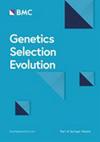具有特定性状标记权重、计算可行的多性状单步基因组预测模型
IF 3.1
1区 农林科学
Q1 AGRICULTURE, DAIRY & ANIMAL SCIENCE
引用次数: 0
摘要
全基因组标记数据的区域可能对所评估的性状有不同的影响。这可以通过给标记分配不同权重反映在基因组模型中,从而提高基因组预测的准确性。然而,当允许性状具有不同的标记权重时,标准的多性状单步基因组评估模型在计算上可能是不可行的。在本研究中,我们开发并实施了一种用于大型基因组数据评估的多性状单步单核苷酸多态性最佳线性无偏预测(SNPBLUP)模型,该模型允许使用预先计算的性状特异性标记权重。对标准单步 SNPBLUP 模型的修改很小,不会显著增加预处理工作量。根据结果,与不带权重的标准单步模型相比,每次迭代所需的内存和计算时间略有增加。此外,使用标记权重时,模型的收敛速度较慢,导致总计算时间延长。不过,使用标记权重提高了预测准确率。我们研究了一种可用于容纳特异性标记权重的单步 SNPBLUP 模型。标记加权单步模型提高了预测准确性。这种方法可用于使用预计算标记权重的大型基因组数据评估。本文章由计算机程序翻译,如有差异,请以英文原文为准。
A computationally feasible multi-trait single-step genomic prediction model with trait-specific marker weights
Regions of genome-wide marker data may have differing influences on the evaluated traits. This can be reflected in the genomic models by assigning different weights to the markers, which can enhance the accuracy of genomic prediction. However, the standard multi-trait single-step genomic evaluation model can be computationally infeasible when the traits are allowed to have different marker weights. In this study, we developed and implemented a multi-trait single-step single nucleotide polymorphism best linear unbiased prediction (SNPBLUP) model for large genomic data evaluations that allows for the use of precomputed trait-specific marker weights. The modifications to the standard single-step SNPBLUP model were minor and did not significantly increase the preprocessing workload. The model was tested using simulated data and marker weights precomputed using BayesA. Based on the results, memory requirements and computing time per iteration slightly increased compared to the standard single-step model without weights. Moreover, convergence of the model was slower when using marker weights, which resulted in longer total computing time. The use of marker weights, however, improved prediction accuracy. We investigated a single-step SNPBLUP model that can be used to accommodate trait-specific marker weights. The marker-weighted single-step model improved prediction accuracy. The approach can be used for large genomic data evaluations using precomputed marker weights.
求助全文
通过发布文献求助,成功后即可免费获取论文全文。
去求助
来源期刊

Genetics Selection Evolution
生物-奶制品与动物科学
CiteScore
6.50
自引率
9.80%
发文量
74
审稿时长
1 months
期刊介绍:
Genetics Selection Evolution invites basic, applied and methodological content that will aid the current understanding and the utilization of genetic variability in domestic animal species. Although the focus is on domestic animal species, research on other species is invited if it contributes to the understanding of the use of genetic variability in domestic animals. Genetics Selection Evolution publishes results from all levels of study, from the gene to the quantitative trait, from the individual to the population, the breed or the species. Contributions concerning both the biological approach, from molecular genetics to quantitative genetics, as well as the mathematical approach, from population genetics to statistics, are welcome. Specific areas of interest include but are not limited to: gene and QTL identification, mapping and characterization, analysis of new phenotypes, high-throughput SNP data analysis, functional genomics, cytogenetics, genetic diversity of populations and breeds, genetic evaluation, applied and experimental selection, genomic selection, selection efficiency, and statistical methodology for the genetic analysis of phenotypes with quantitative and mixed inheritance.
 求助内容:
求助内容: 应助结果提醒方式:
应助结果提醒方式:


